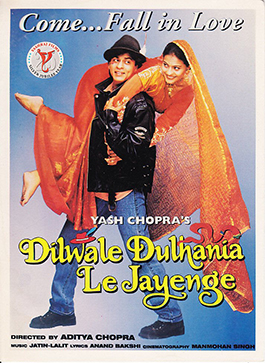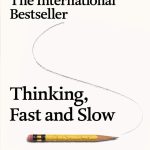1. Sholay (1975) –
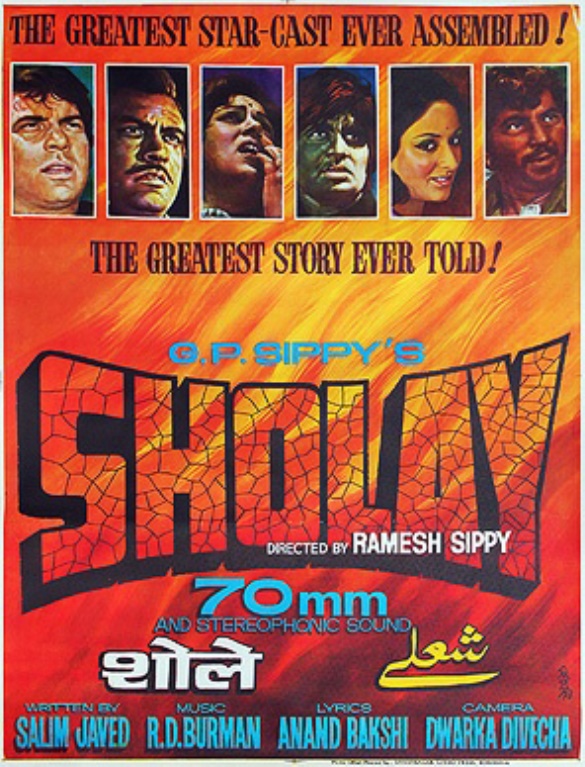
“Sholay” is one of the classic Hindi movies action-adventure films released in 1975, directed by Ramesh Sippy and produced by his father G.P. Sippy. The movie features an ensemble cast of veteran actors including Dharmendra, Amitabh Bachchan, Hema Malini, Sanjeev Kumar, Jaya Bachchan, and Amjad Khan.
Set in a fictional village in India, the plot revolves around a retired police officer who hires two small-time crooks, Veeru and Jai, to capture a ruthless dacoit, Gabbar Singh, who has been terrorizing the village. As the duo sets out on their mission, they encounter various obstacles and challenges, including Gabbar’s henchmen and their own personal demons.
The film is known for its iconic characters, dialogues, and action sequences. Amitabh Bachchan’s portrayal of the brooding and fearless Jai became an instant classic, while Amjad Khan’s portrayal of Gabbar Singh as a cold-blooded and ruthless villain is still regarded as one of the best in Indian cinema. The film also features memorable songs, including the evergreen “Yeh Dosti” and “Holi Ke Din.”
“Sholay” was a massive commercial success, running for more than five years in a single theater in Mumbai, and winning numerous awards, including the National Film Award for Best Popular Film Providing Wholesome Entertainment. It has since become a cultural phenomenon and is often considered one of the greatest Indian films of all time.
2. Mughal-e-Azam (1960) –

“Mughal-e-Azam” is a classic Bollywood film released in 1960, directed by K. Asif and produced by Shapoorji Pallonji. The movie is set in the Mughal era of India and tells the story of the love affair between Prince Salim (played by Dilip Kumar) and the court dancer Anarkali (played by Madhubala), which leads to a conflict with Salim’s father, the Mughal Emperor Akbar (played by Prithviraj Kapoor).
The film is known for its opulent sets, costumes, and grandeur, which captured the essence of the Mughal era. The elaborate dance sequences and songs, such as “Jab Pyaar Kiya Toh Darna Kya” and “Teri Mehfil Mein Qismat,” are still popular today.
“Mughal-e-Azam” was a groundbreaking film for its time, featuring advanced filming techniques, including the use of color, which was still a novelty in Indian cinema at the time. It was also one of the most expensive Indian films ever made, with a budget of over 15 million rupees, and took more than 16 years to complete.
The film was a critical and commercial success, breaking box office records and winning numerous awards, including the National Film Award for Best Feature Film in Hindi. It has since become a classic in Indian cinema and is often cited as one of the greatest Indian films ever made. Its enduring popularity is a testament to the timeless nature of its story and its unforgettable visuals.
3. Dilwale Dulhania Le Jayenge (1995) –
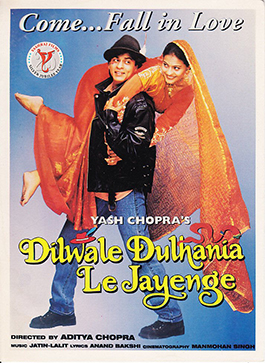
“Dilwale Dulhania Le Jayenge” (DDLJ) is a Bollywood romantic film released in 1995, directed by Aditya Chopra and produced by Yash Chopra. The movie features Shah Rukh Khan and Kajol in lead roles, along with a supporting cast of veteran actors like Amrish Puri, Farida Jalal, and Anupam Kher.
The story of the film revolves around Raj (played by Shah Rukh Khan), a carefree and romantic young man who falls in love with Simran (played by Kajol), a traditional and conservative girl from a Punjabi family. They meet while on a trip to Europe and fall in love, but Simran’s father has already arranged her marriage to someone else. The film follows their journey as they try to win over Simran’s father and overcome the obstacles in their path.
DDLJ is known for its iconic dialogues, memorable songs, and picturesque locations. The film’s soundtrack, composed by Jatin-Lalit, includes hit songs like “Mere Khwabon Mein Jo Aaye,” “Tujhe Dekha Toh Yeh Jaana Sanam,” and “Ruk Ja O Dil Deewane.”
The film was a massive commercial success, running for more than 1000 weeks in a single theater in Mumbai, and became the highest-grossing Bollywood film of its time. It also won numerous awards, including 10 Filmfare Awards, and has since become a cultural phenomenon and an iconic representation of love in Indian cinema.
DDLJ’s impact on Indian cinema and pop culture has been significant, with the film inspiring a generation of filmmakers and actors. Its story of young love and familial values continues to resonate with audiences across generations and has cemented its place in the annals of Indian film history.
4. Lagaan (2001) –
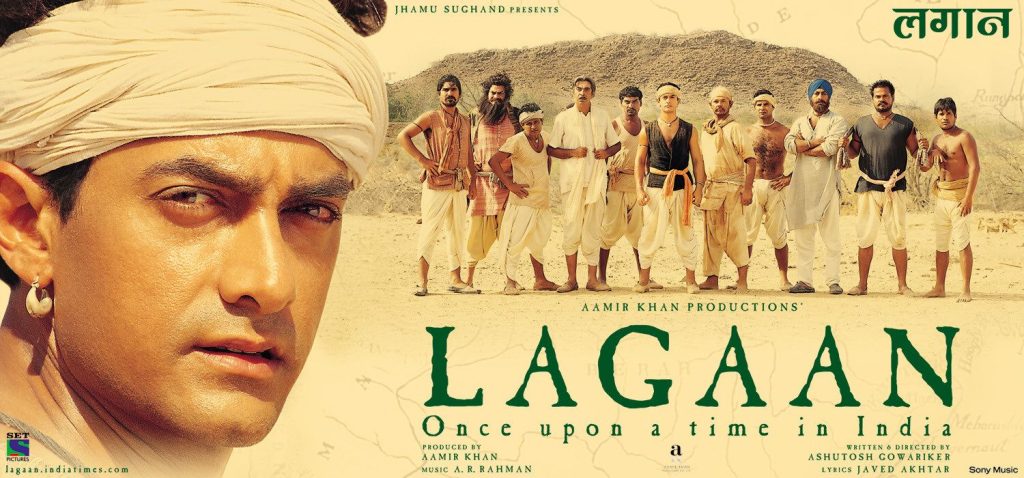
“Lagaan” is a Bollywood sports drama film released in 2001, directed by Ashutosh Gowariker and produced by Aamir Khan. The movie features Aamir Khan in the lead role, along with an ensemble cast of Gracy Singh, Rachel Shelley, Paul Blackthorne, and Kulbhushan Kharbanda.
The film is set in the late 19th century during the British Raj and tells the story of a group of Indian villagers who are oppressed by the high taxes levied by their British rulers. When the British officers challenge them to a game of cricket, with the promise of tax relief if they win, the villagers rise to the occasion and form their own team, with the help of a young and passionate Bhuvan (played by Aamir Khan).
“Lagaan” is known for its portrayal of colonial India and its themes of national pride and unity. The film’s music, composed by A. R. Rahman, includes hit songs like “Mitwa,” “Chale Chalo,” and “Radha Kaise Na Jale.”
The film was a massive commercial and critical success, winning numerous awards, including eight National Film Awards and three Filmfare Awards, including Best Film, Best Director, and Best Actor for Aamir Khan. It was also nominated for the Academy Award for Best Foreign Language Film, making it the third Indian film to receive this honor.
“Lagaan” is widely regarded as a milestone in Indian cinema and is often cited as one of the greatest sports films of all time. Its impact on Indian cinema has been significant, with the film inspiring a new wave of filmmakers to explore diverse themes and genres.
5. Mother India (1957) –

“Mother India” is a Bollywood epic drama film released in 1957, directed by Mehboob Khan and produced by Mehboob Productions. The movie stars Nargis in the lead role, along with a supporting cast of Sunil Dutt, Rajendra Kumar, and Raaj Kumar.
The film is set in rural India and tells the story of Radha (played by Nargis), a strong-willed woman who struggles to make ends meet for her family in the face of poverty and adversity. The film follows her journey as she faces a series of challenges, including a devastating drought, the loss of her husband, and the temptation of her son’s criminal behavior.
“Mother India” is known for its powerful portrayal of the struggles of rural life and its themes of sacrifice, resilience, and motherhood. The film’s music, composed by Naushad, includes hit songs like “Duniya Mein Hum Aaye Hain,” “O Gaadiwale,” and “Nagari Nagari Dware Dware.”
The film was a massive commercial and critical success, becoming the highest-grossing Indian film of its time and receiving widespread acclaim for its performances, direction, and cinematography. It was also nominated for the Academy Award for Best Foreign Language Film, making it the first Indian film to receive this honor.
“Mother India” is widely regarded as a masterpiece of Indian cinema and an iconic representation of Indian culture and values. Its impact on Indian cinema has been significant, inspiring generations of filmmakers and actors to explore themes of social justice and the human condition.
6. Guide (1965) –

“Guide” is a Bollywood drama film released in 1965, directed by Vijay Anand and produced by Dev Anand. The movie features Dev Anand and Waheeda Rehman in the lead roles, along with a supporting cast of Leela Chitnis, Kishore Sahu, and Gajanan Jagirdar.
The film is based on the novel “The Guide” by R.K. Narayan and tells the story of Raju (played by Dev Anand), a tour guide who becomes a spiritual guru and leads a group of followers in a remote village. He falls in love with a married woman named Rosie (played by Waheeda Rehman), and together they embark on a journey of self-discovery and liberation.
“Guide” is known for its exploration of themes of love, spirituality, and self-discovery. The film’s music, composed by S.D. Burman, includes hit songs like “Gaata Rahe Mera Dil,” “Din Dhal Jaaye,” and “Tere Mere Sapne.”
The film was a commercial and critical success, winning several awards, including seven Filmfare Awards, including Best Film, Best Director, and Best Actor for Dev Anand. It was also nominated for the Palme d’Or at the Cannes Film Festival, making it the first Indian film to receive this honor.
“Guide” is widely regarded as a classic of Indian cinema and an iconic representation of Indian art and culture. Its impact on Indian cinema has been significant, inspiring generations of filmmakers and actors to explore themes of spirituality and personal growth.
7. Pyaasa (1957) –
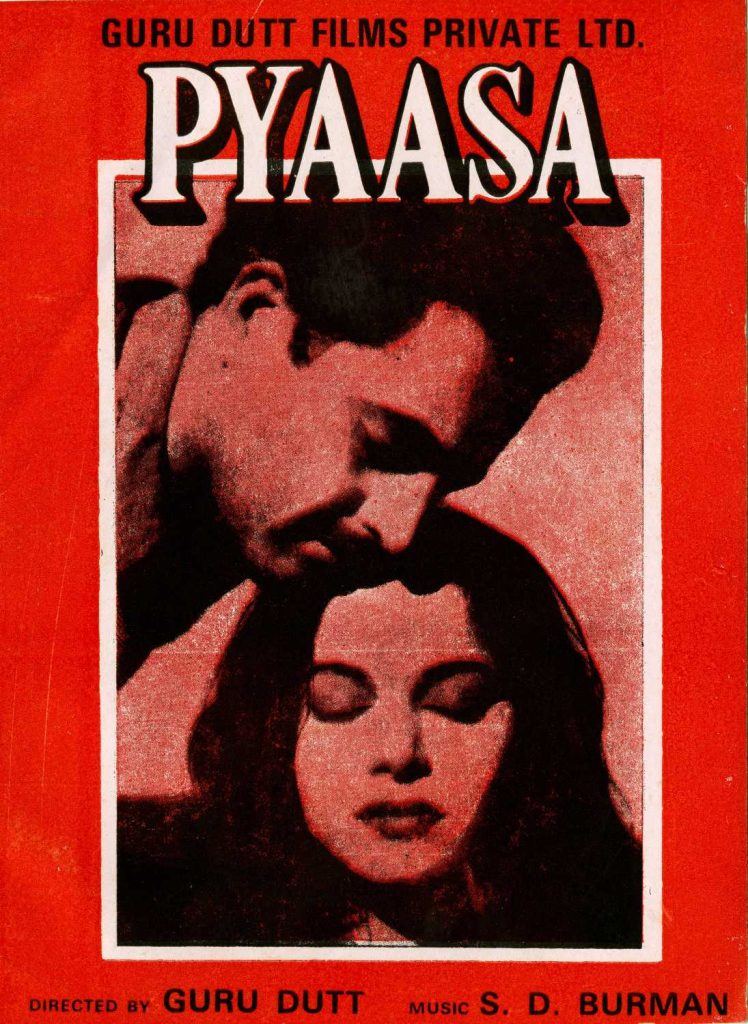
“Pyasa” is a Bollywood drama film released in 1957, directed by Guru Dutt and produced by his own production house, Guru Dutt Films. The movie stars Guru Dutt in the lead role, along with Waheeda Rehman, Mala Sinha, and Rehman in supporting roles.
The film is set in post-independence India and tells the story of Vijay (played by Guru Dutt), a struggling poet who is rejected by society for his ideals and beliefs. He falls in love with a prostitute named Gulabo (played by Waheeda Rehman) and together they confront the harsh realities of society.
“Pyasa” is known for its exploration of themes of love, spirituality, and social inequality. The film’s music, composed by S.D. Burman, includes timeless classics like “Jaane Woh Kaise Log,” “Yeh Duniya Agar Mil Bhi Jaaye,” and “Hum Aapki Aankhon Mein.”
The film was a commercial and critical success, winning several awards, including the Filmfare Award for Best Film and the National Film Award for Best Feature Film in Hindi. It was also listed in TIME magazine’s “All-TIME 100 Movies” list in 2005.
“Pyasa” is widely regarded as a classic of Indian cinema and an iconic representation of Guru Dutt’s artistic vision. Its impact on Indian cinema has been significant, inspiring generations of filmmakers and actors to explore themes of social justice and artistic expression.
8. Deewaar (1975) –
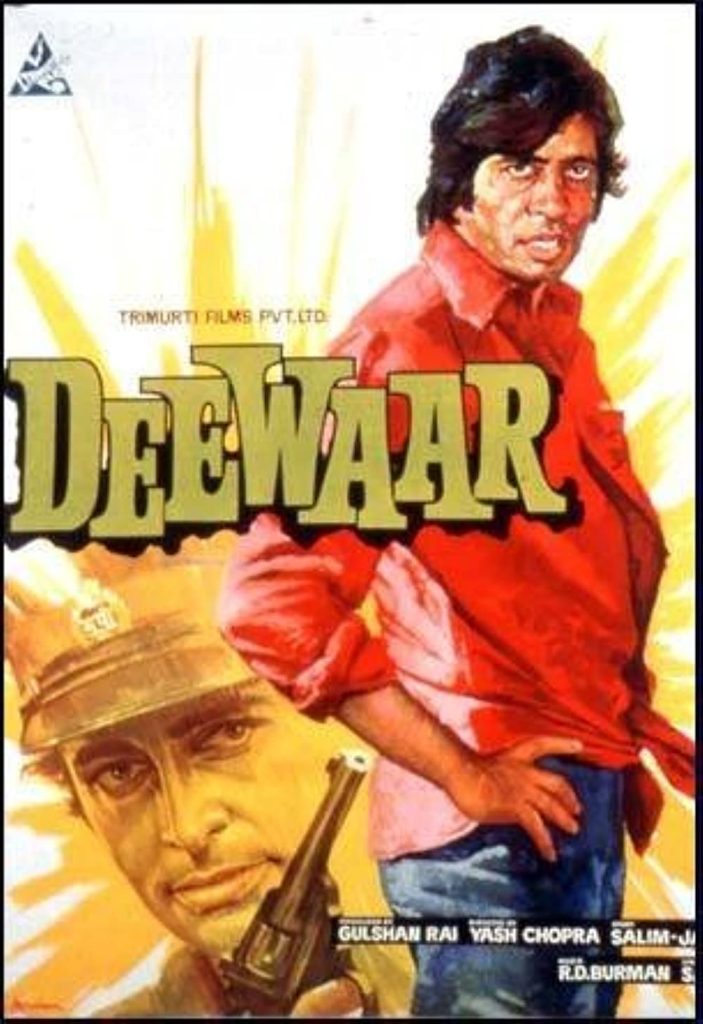
“Deewaar” is a Bollywood crime drama film released in 1975, directed by Yash Chopra and produced by Gulshan Rai. The movie features Amitabh Bachchan and Shashi Kapoor in the lead roles, along with Nirupa Roy, Parveen Babi, and Neetu Singh in supporting roles.
The film is set in Mumbai and tells the story of two brothers, Vijay (played by Amitabh Bachchan) and Ravi (played by Shashi Kapoor), who take different paths in life. Vijay becomes a gangster and Ravi becomes a police officer. The film explores the complex relationship between the two brothers and their conflicting ideologies.
“Deewaar” is known for its exploration of themes of morality, social inequality, and the human condition. The film’s music, composed by R.D. Burman, includes iconic songs like “Keh Doon Tumhe,” “Idhar Jaaon Ya Udhar Jaaon,” and “Tere Bina Zindagi Se.”
The film was a massive commercial and critical success, becoming one of the highest-grossing Indian films of its time and winning several awards, including the Filmfare Award for Best Film, Best Director, and Best Actor for Amitabh Bachchan. It was also listed in TIME magazine’s “All-TIME 100 Movies” list in 2005.
“Deewaar” is widely regarded as a classic of Indian cinema and an iconic representation of the gritty, urban underworld of Mumbai. Its impact on Indian cinema has been significant, inspiring generations of filmmakers and actors to explore themes of social justice and the complexity of human relationships.
9. Kabhi Kabhie (1976) –
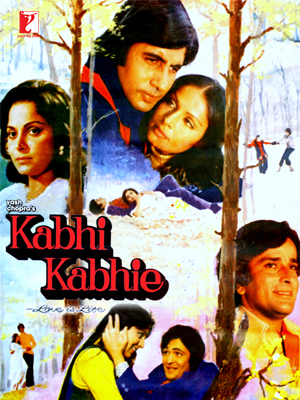
“Kabhi Kabhie” is a Bollywood romantic drama film released in 1976, directed by Yash Chopra and produced by Yash Chopra and his wife, Pamela Chopra. The movie features an ensemble cast, including Amitabh Bachchan, Shashi Kapoor, Rakhee Gulzar, Waheeda Rehman, Rishi Kapoor, and Neetu Singh.
The film tells the story of two lovers, Amit (played by Amitabh Bachchan) and Pooja (played by Rakhee Gulzar), who are separated by fate and societal norms. The story is told through the perspective of their children, who discover their love story years later and try to reunite them.
“Kabhi Kabhie” is known for its exploration of themes of love, family, and societal expectations. The film’s music, composed by Khayyam, includes memorable songs like “Kabhi Kabhie Mere Dil Mein,” “Tere Chehre Se Nazar Nahin,” and “Main Pal Do Pal Ka Shayar Hoon.”
The film was a commercial and critical success, winning several awards, including the Filmfare Award for Best Film, Best Director, and Best Supporting Actress for Rakhee Gulzar. It was also nominated for several other awards, including the BAFTA Award for Best Foreign Language Film.
“Kabhi Kabhie” is widely regarded as a classic of Indian cinema and an iconic representation of Yash Chopra’s directorial style. Its impact on Indian cinema has been significant, inspiring generations of filmmakers and actors to explore themes of love, family, and societal expectations.
10. Anand (1971) –
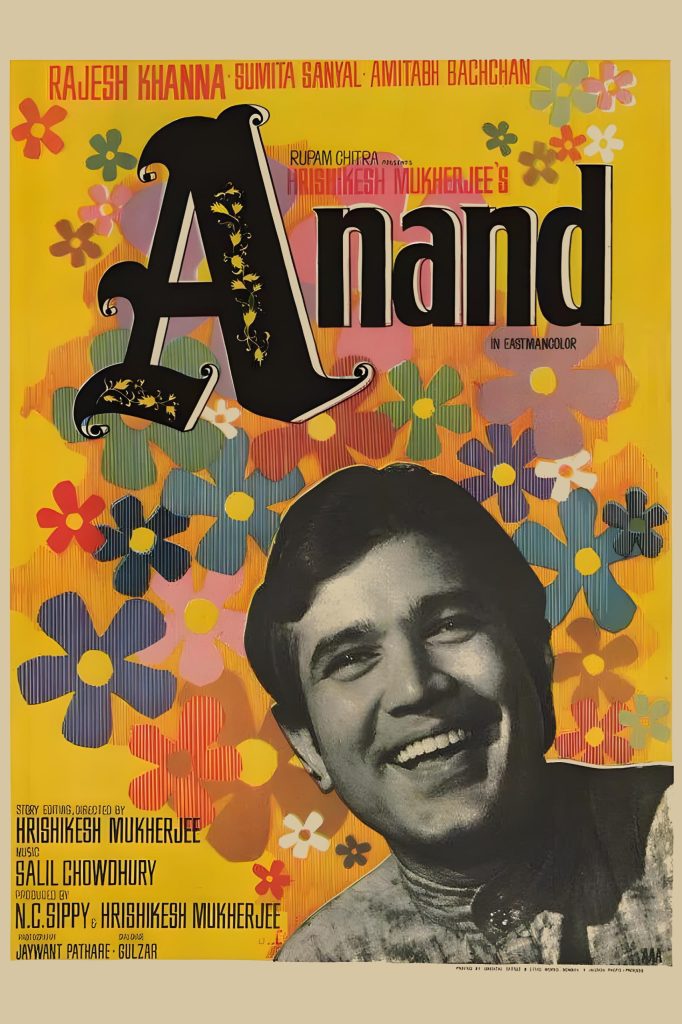
“Anand” is a Bollywood drama film released in 1971, directed by Hrishikesh Mukherjee and produced by Hrishikesh Mukherjee and N.C. Sippy. The movie stars Rajesh Khanna and Amitabh Bachchan in the lead roles, along with Sumita Sanyal, Ramesh Deo, and Seema Deo in supporting roles.
The film tells the story of Anand (played by Rajesh Khanna), a young man suffering from a terminal illness who chooses to live life to the fullest and spread happiness to those around him. The story is told through the eyes of his close friend and doctor, Bhaskar (played by Amitabh Bachchan), who struggles to come to terms with Anand’s impending death.
“Anand” is known for its exploration of themes of life, death, and the human condition. The film’s music, composed by Salil Chowdhury, includes memorable songs like “Zindagi Kaisi Hai Paheli,” “Kahin Door Jab Din Dhal Jaaye,” and “Maine Tere Liye Hi Saat Rang Ke Sapne.”
The film was a massive commercial and critical success, becoming one of the highest-grossing Indian films of its time and winning several awards, including the Filmfare Award for Best Film, Best Director, Best Actor for Rajesh Khanna, and Best Supporting Actor for Amitabh Bachchan.
“Anand” is widely regarded as a classic of Indian cinema and an iconic representation of Hrishikesh Mukherjee’s directorial style. Its impact on Indian cinema has been significant, inspiring generations of filmmakers and actors to explore themes of life, death, and the importance of living in the moment.

